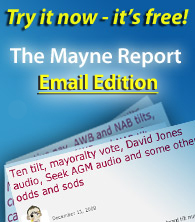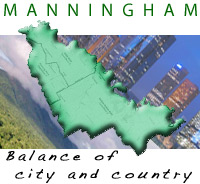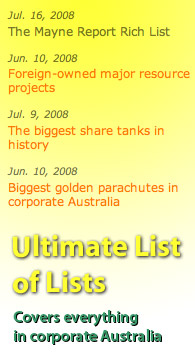Michael Maxwell bonus, 3AW GM removed, misleading pay at B&B and their tardiness
July 22, 2008
Here are Stephen Mayne's four stories from the Crikey edition on Monday, April 24, 2006.
5. Huge bonus for B&B's property man
By Stephen Mayne, shareholder in GPT, Westfield and Babcocks
Michael Maxwell, th
Advertisement
e Babcock & Brown executive who stitched up GPT in last year's controversial joint venture deal, has been rewarded with a huge bonus, according to the 2005 annual report which was released this morning.
Maxwell's overall pay rocketed from $3.77 million in 2004, when he was the sixth highest paid Babcocks executive, to $10.06 million in 2005, second only to fast-talking CEO Phil Green, whose pay packet rose from $10.3 million to a record $12.18 million.
Maxwell's real estate operation was the first division covered in the annual report and the GPT deal got plenty of positive mentions, suggesting it was a major factor in the board's decision to give Maxwell a hefty $8.63 million short term bonus.
The five highlights in the annual report explaining the surge in property net revenue from $79.4 million to $297.17 million included two revolving around GPT which were as follows:
- Revenue from real estate transactions involving the GPT joint venture
- Income from ownership and partial sale of portfolios of residential property in Germany prior to the establishment of the GPT joint venture
Having listened to all the arguments at last week's GPT AGM, I reckon the company would have been far better off simply ditching Lend Lease and internalising management. There was no need to simultaneously do the imbalanced joint venture with Babcocks and even less justification for selling those two shopping centres to Westfield at book value, just to secure its 6.5% voting stake in favour of the inter-linked proposals.
The ASX remains in disgrace for allowing Westfield to vote on the deal and the actions of the entire GPT board are still open to debate. GPT chairman Peter Joseph last week claimed the company "could right the book on independence", which is right at one level because they did ultimately ditch the manager that appointed them.
However, two of the current GPT directors, Ian Martin and Elisabeth Nosworthy, also sit on the Babcocks board and Joseph himself has enjoyed a GPT pay rise from $120,000 to $300,000. Faced with the sack or almost tripling his pay, Joseph had a strong incentive to be the brave independent.
Then you have Joseph's history with Frank Lowy. When Lowy's Westfield Capital Corporation took a defensive 20% stake in the once-great engineering giant ANI shortly before the 1987 crash, Joseph and David Gonski joined the board as his representatives.
Given the miraculous way Westfield wriggled out of some of its exposure in 1988, you would have to ask whether Joseph was indeed independent, because last year's GPT was the second time in history that Lowy has come out smiling after doing a deal with Joseph.
The massive $621 million paid by GPT in March for a half share in Melbourne's Highpoint shopping centre confirmed the generosity of the book value deal with Westfield and now we have Michael Maxwell's huge Babcocks bonus as further confirmation that GPT unitholders got the worst of all these dealings.
20. Handling the big egos of AFL radio calling
By Stephen Mayne
Australia's most profitable and high-rating talk radio station, Melbourne's 3AW, is in the midst of some unusual instability courtesy of concerns about its AFL football calling and the role of the screaming fisherman, Rex Hunt. The ructions came to a head last week when 3AW General Manager, Shane Healy, was removed from his post, although he'll remain an executive within 3AW's parent company, Southern Cross Broadcasting.
Ditching Healy surprised many observers because he was in charge of 3AW's high-risk change of frequency which takes effect on 1 May. It remains to be seen whether the ageing army of 3AW listeners will have the ability to get out of their rocking chairs and switch the dial from 1278 to 693.
While the frequency hopping is controversial, it was management dissatisfaction with the football coverage that triggered the move on Healy. Southern Cross Broadcasting's overall radio boss, Graham Mott, has now personally taken management responsibility for the AFL coverage.
Earlier this year Healy appointed "Race Track" Ralph Horwitz as football producer. Horwitz employed former Channel Seven reporter Craig Hutchison to host the pre-match coverage and call with Dwayne Russell on Saturday night. While management appear to be dissatisfied with Hutchinson's calling, it's believed the station's number one caller Rex Hunt has not been happy with his involvement in the pre-match coverage.
Hunt is also unhappy with Horwitz producing the program from the commentary box rather than the studio. Horwitz has told colleagues that "producing from the studio is like producing from the moon" but Hunt works best when flying by the seat of his pants, not when being heavily structured.
The footy on 3AW this year has been introduced by a loud rock track as part of a concerted effort to "go young" in opposition to MMM, where Hutchison worked for the previous eight years. In doing this there is always the danger of losing the core elderly audience, something Mott was loath to do. Already the rock track is gone and Hunt is now the first voice you hear, not Hutchison.
Meanwhile, Sam Newman walked out of the MMM commentary box at half time in disgust on Saturday, supposedly because Geelong and the Western Bulldogs were playing an ugly brand of football. The two most fancied Melbourne-based clubs ended up playing a classic which the Bulldogs won by a point, so Newman is left looking stupid and MMM is failing to take advantage of 3AW's own problems, although some cynics reckon it was just another publicity stunt.
Newman and Hunt used to be great mates and worked together for many years on 3AW but ended up falling out, partly because Eddie McGuire poached Newman to MMM in 2000 on a huge package. The secret of dealing with their rampant egos is anyone's guess.
25. Comparing the misleading pay packets at Babcock & Brown
By Stephen Mayne, proud owner of 32 Babcock & Brown shares
When the 2006 BRW Rich List arrives on 18 May, at least half a dozen Babcock & Brown executives should feature for the first time, assuming last year's $110 million threshold isn't dramatically increased.
It is worth dwelling on the announced pay packets in this morning's annual report and then contemplating how these have been dramatically under-stated over the past two years. Let's rank the top 10 from 2005, but include the comparisons from 2004.
| Name | Position | 2005 pay | 2004 pay |
| Phil Green | CEO | $12.18m | $10.32m |
| Michael Maxwell | property boss | $10.06m | $3.77m |
| Peter Hofbauer | infrastructure boss | $9.44m | $4.65m |
| Martin Rey | Europe boss | $7.03m | $3.54m |
| Steven Zissis | aircraft leasing boss | $5.73m | $10.26m |
| David Ross | chief operating officer | $5.64m | $2.02m |
| Robert Topfer | corporate finance boss | $5.09m | $4.67m |
| James Babcock | executive chairman | $4.62m | $4.97m |
| Daniel Brickman | structured finance boss | $4.47m | $4.09m |
| James Fantaci | US and leasing boss | $4.41m | $2.4m |
While it looks like most have had a decent pay rise, the only problem with this is that the 2004 figures are grossly understated because a slew of options that were issued the day before the October 2004 float, at just $5 a share, were only valued at $1.27 each.
Take CEO Phil Green. He was issued 800,000 options exercisable at $5 each on 5 October, 2004, but this was only valued at $1.016 million in the 2004 pay tables. Given the stock opened at $7.98 on 6 October, 2004, they were actually worth $2.4 million one day after they were issued – more than double the valuation used in the annual report which came out six months later.
If you take the current market price of $17.95, Green's pre-float options grant are $10.36 million in the money. This increases the value of his 2004 pay packet to almost $20 million and means he has actually taken a substantial pay cut in 2005.
Therefore, the above chart, derived from the 2005 Babcock annual report, is completely misleading because of the ridiculously low options valuations. This is a rort that is rife right across the listed company sector, although today's example is one of the worst we've seen.
It's time to put an end to this and have the value of earlier option grants adjusted to reflect the market price each year. Let's hope today's Babcock annual report will finally bell the toll and prompt a decent debate among regulators, institutions and shareholder groups about how equity grants are valued because at the moment they are being systematically under-stated.
26. Babcock's tardy annual report release
By Stephen Mayne
It's not often that shareholders receive a hard copy of an annual report and notice of meeting before it is lodged with the ASX. But that's exactly what happened with the controversial outfit Babcock & Brown this morning.
The aggressive investment bank were obviously very proud of their past year because there were two copies of the 2005 annual report and notice of meeting in my PO Box at 8am today. This was before it had been lodged with the ASX later in the morning and comes right in the middle of what is an Anzac Day long weekend for many people, including those hard-working souls at The AFR who publish nothing between Saturday and Wednesday.
All this is quite odd, because it means Babcock had presumably physically sent annual reports to its 23,575 registered shareholders on Thursday or Friday last week, but hadn't bothered to lodge it with the ASX.
The Babcock annual report has been the most anticipated of all reports for 31 December balance date companies and I've already booked my flights for the AGM on May 26 at the Four Seasons in Sydney. Just like Macquarie Bank, it is incredibly issues-rich company for journalists, analysts and shareholder activists alike.
Executive pay has sky-rocketed again, the non-executive directors will be getting a juicy pay rise to almost $300,000 this year and there is a slew of resolutions to approve the issue of various equity incentives to different directors and managers of the company which last year paid an average of almost $1 million to each of its staff.
The total pay pool reached $421 million in 2005 – $300 million in bonuses and $121 million in base pay – as global staff numbers rose from 455 to 642 over the 12 months to 31 December. Macquarie Bank pays at about half this level on average, although there are bigger bonuses right at the top given both Allan Moss and Nicholas Moore cracked $18 million last year.
The Babcock annual report launches a new marketing look for the company, but the poo brown cover isn't particularly appealing. However, they won't be in the poo at the AGM because the share price has soared from $7.98 on debut in October 2004, to $17.95 this morning.
The company has certainly increased its debt and risk profile over the year, but the market has been sold by the story as audited net assets of $1.11 billion are dwarfed by today's market capitalisation of $4.4 billion, although they doesn't include the valuation of several hundred million dollars worth of unexercised options or performance rights which are well in the money.
Copyright © 2024 The Mayne Report. All rights reserved






















